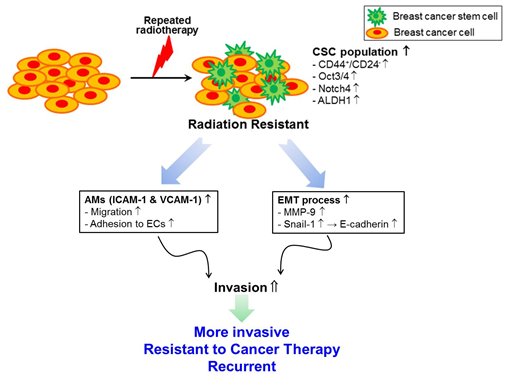글로벌 연구동향
방사선생물학
- 2019년 01월호
[Oncol Rep.] 방사선저항성 유방암세포의 형질연구 Radioresistant breast cancer cells exhibit increased resistance to chemotherapy and enhanced invasive properties due to cancer stem cells.경상의대 / 고영신, 김혜정*, 정배권*
- 출처
- Oncol Rep.
- 등재일
- 2018 Dec
- 저널이슈번호
- 40(6):3752-3762. doi: 10.3892/or.2018.6714. Epub 2018 Sep 18.
- 내용

Abstract
Previous studies suggest that cancer stem cells (CSCs) exist in solid tumors, and contribute to therapeutic resistance and disease recurrence. Therefore, the present study aimed to investigate whether radioresistant (RT‑R) breast cancer cells derived from breast cancer cells increase the number of CSCs, and whether these CSCs are responsible to increased invasiveness and therapeutic resistance. MCF‑7, T47D and MDA‑MB‑231 cells were irradiated 25 times (2 Gy each; 50 Gy total) to generate radioresistant breast cancer cells (RT‑R‑MCF‑7, RT‑R‑T47D and RT‑R‑MDA‑MB‑231). RT‑R‑breast cancer cells demonstrated increased cell viability against irradiation and increased colony forming abilities compared with parental breast cancer cells. Particularly, RT‑R‑MDA‑MB‑231 cells derived from highly metastatic MDA‑MB‑231 cells exhibited most radioresistance and chemoresistance of the three cell lines. In addition, MDA‑MB‑231 cells exhibited the most increased protein levels of CSCs markers cluster of differentiation 44, Notch‑4, octamer‑binding transcription factor 3/4 and aldehyde dehydrogenase 1, compared with RT‑R‑MCF‑7 cells, suggesting highly metastatic breast cancer cells MDA‑MB‑231 produce more CSCs. RT‑R‑MDA‑MB‑231 cells increased intercellular adhesion molecule‑1 and vascular cell adhesion molecule‑1 levels, resulting in enhanced migration and adhesion to endothelial cells (ECs), and enhanced invasiveness through ECs by inducing matrix metalloproteinase‑9, Snail‑1 and β‑catenin, and by downregulating E‑cadherin compared with MDA‑MB‑231 cells. These results suggest that highly metastatic breast cancer cells may increase the number of CSCs following radiation therapy, and CSCs present in RT‑R‑MDA‑MB‑231 cells contribute to the enhanced invasiveness by increasing migration, adhesion to ECs and invasion through ECs by promoting epithelial‑mesenchymal transition (EMT) via the upregulation of adhesion molecules and EMT‑associated proteins.
Author informationKo YS1, Jin H1, Lee JS2, Park SW1, Chang KC1, Kang KM3, Jeong BK3, Kim HJ1.
1
Department of Pharmacology, School of Medicine, Institute of Health Sciences, Gyeongsang National University, Jinju 52727, Republic of Korea.
2
Department of Pathology, School of Medicine, Institute of Health Sciences, Gyeongsang National University, Jinju 52727, Republic of Korea.
3
Department of Radiation Oncology, School of Medicine, Institute of Health Sciences, Gyeongsang National University, Jinju 52727, Republic of Korea.
- 연구소개
- 최근 암줄기세포(cancer stem cell)가 종양세포안에 존재하여 암치료 내성 및 재발에 관여한다고 보고되고 있음. 따라서 본 논문에서는, 임상에서 유방암 환자의 치료에 사용되는 치료선량을 전이성이 높다고 알려진 MDA-MB-231 유방암 세포주에 반복적으로 조사하였을때(2Gy/회, 25회, 총 50Gy), 방사선 및 항암제에 대하여 저항성을 나타내는 유방암 세포주가 구축됨을 확인하였음. 또한 방사선저항성 유방암세포에서는 암줄기세포가 많이 존재하며 전이성이 증가함을 규명하였음. 따라서, 본 연구는 유방암의 방사선치료 및 항암치료시 암줄기세포를 줄이는 치료방안이 함께 고려하는 것이 임상적 치료성적을 높일 수 있다고 제시함.
- 덧글달기







